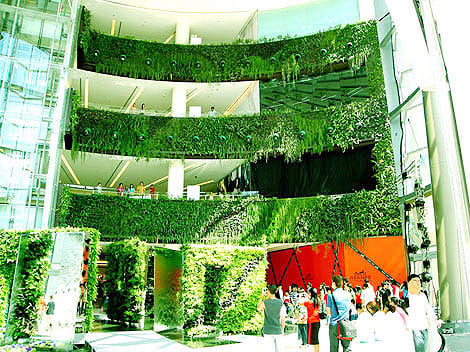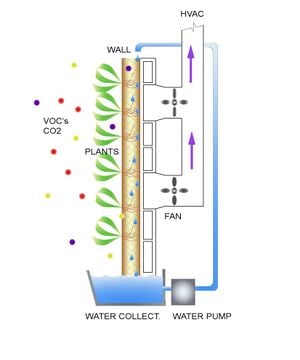m (Bot: Adding {{catneeded}} tag to uncategorized pages) |
|||
| Line 61: | Line 61: | ||
* Must be careful to choose plants that won't release excessive pollen. | * Must be careful to choose plants that won't release excessive pollen. | ||
* Plants must be maintained. Including, trimming, watering, replanting, and washing. | * Plants must be maintained. Including, trimming, watering, replanting, and washing. | ||
{{catneeded}} | |||
Revision as of 14:31, 21 December 2009
What are Living Walls?

- Living walls are vertically oriented gardens usually climbing a wall of a building or structure. Living walls have been used for centuries in Europe; whether this was an intentional use of living walls or a natural process of local fauna overtaking an available medium probably depended on your class and knowledge.Today Living walls are re-entering the spotlight as an environmentally friendly way to reduce energy costs and bring nature back in to the human landscape.
- Living walls are a relatively untapped art and architecture medium.Growing plants become a dynamic and evolving artwork that requires periodic upkeep.
- Living walls can be purely decorative, produce food or medicinal plants in small areas, provide energy savings through reduced heat absorption and even improve the quality of indoor air.
Why build living walls?
Health benefits
According to the U.S. EPA, Indoor air quality can sometimes be much worse than the outdoor air quality of the most polluted cities. Constant exposure to poor air quality can cause asthma, irritation, and a myriad of other health problems. Poor indoor air quality is often due to poor ventilation and off gassing of Volatile Organic Compounds from carpets, paints, upholstery, insulation,and countless other common products. Remedies for poor air on a small scale is limited to opening windows and fans while large scale systems often use HVAC systems. Living walls can be used on any scale to improve the indoor air quality.
Living Walls provide health benefits on both the physical and psychological levels. The plants using co2 and circulating the air in the room remove VOC's from the ambient air. This reduces negative health impacts associated with VOC's and poor indoor air. On a psychological level, plants can provide a calming effect on a room as well as increase worker efficiency. Quantifying a psychological benefit from plants in a persons space is somewhat difficult. However, qualitative reports of general improvement in mood and calmness are common in measuring effects of plants on human psychology.
Living walls can improve air quality through the photosynthesizing; absorbing CO2 and emitting oxygen.
Energy savings
Exterior walls Reduces heat island effect- The suns energy that used to reflect and radiate heat off of buildings is now absorbed by the growing plants. Reduces indoor cooling needs and costs- Shading from the plants on an exterior wall can decrease the temperature inside the building. Lower temperatures indoors reduce the need for air conditioning.
Noise reduction
Living walls absorb sound waves reducing city noise.
Reduces Storm Water Runoff
Soil absorbs rain, reducing runoff.
Protects the Building
- Absorbs acid rain, keeping it off the building.
- Protects against ultra violet rays.
- Reduces temperature change, which reduced expansion and contraction of building materials.
Creates Habitat
Creates Habitat for microorganisms, insects, and birds.
Application/Uses
How do living walls improve indoor air quality?
Air quality is improved by a biological process called biofilration. Air can be forced past the plants and the soil medium containing microbes that actually removes VOC's, dust and dirt particles from the air. The pollutants from the air are absorbed into a liquid phases and consumed by the microbes. The microbes use the pollutants as an energy source and degraded them to carbon dioxide and water. The air is then pumped through the traditional HVAC system and is redistributed in to the building. An estimated 65% to 90% of VOC's have been removed using biofiltration.

How do Living Walls reduces cooling costs?
Shading from the plants on a sunlight wall reduces the amount of direct light hitting the structure. The energy absorbed by the plants is converted in to sugars through photosynthesis instead of reflecting and radiating most of the energy (heat) striking the wall.
Indoor living walls can also reduce cooling/heating costs. Traditional HVAC systems must, by code, replace a certain amount of indoor air with fresh outdoor air every hour. While this is being accomplished the outdoor air must be heated/cooled to the desired indoor temperature. With an indoor living wall system the same air is used over and over again. The air is filtered by the living wall and maintains its temperature, eliminating the need to heating and/or cool outdoor air.
Design
How are Living walls made?
Any plant requires a type of growing medium. Some plants require a lot of medium in order to flourish, other plants need very little. The first element to building a living wall is the physical structure of the wall. Plants need water and moist soil, two things not commonly found anywhere near drywall. Some method of retaining the drip from plants and soil is a good first step.
- build the medium, a rectangle with little cubbies at slight upward angles.
- For a home:
- For a large scale HVAC inter-tied system:
What is the scale of a living wall?
- Living walls can be adapted to almost any size
a photo gallery of living walls
- Examples of large scale
- Examples of small scale, household size
Concerns
- Moisture must be controlled to avoid mold growth.
- Plants will attract insects.
- Must be careful to choose plants that won't release excessive pollen.
- Plants must be maintained. Including, trimming, watering, replanting, and washing.